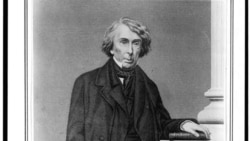From VOA Learning English, this is The Making of a Nation. I’m Kelly Jean Kelly.
And I’m Christopher Cruise.
Early in 1857, the United States Supreme Court announced one of its most important rulings: the case of a man named Dred Scott.
The ruling reversed an earlier law. And, it increased the country’s bitter dispute in the country about whether slavery should be legal.
Who was Dred Scott?
Dred Scott was born a slave in the southern state of Virginia. As a young man he lived in Missouri, where slavery was also legal.
An Army doctor bought Mr. Scott. They moved north, to Illinois and Wisconsin. Slavery was illegal there. Four years later, Mr. Scott and his owner returned to the slave state of Missouri.
There, Dred Scott sued for his freedom. He said he was no longer a slave because he had lived in places where slavery was illegal.
The local court agreed with Mr. Scott and gave him his freedom. But lawyers appealed the decision, and a higher court in Missouri ruled against him.
Mr. Scott took his case to a federal court. Finally, he asked the U.S. Supreme Court to decide if he was a slave or a free man.
What did the court decide?
The Supreme Court announced its decision on the Dred Scott case on March 6, 1857. Chief Justice Roger Taney said Mr. Scott was still a slave.
The chief justice gave three reasons why.
First, he said, Mr. Scott was not a citizen. Chief Justice Taney said the
Because Mr. Scott was not a citizen, he had no right to ask the court even to hear his case.Jean Harvey Baker is a historian. She explains the decision this way: “The court ruled that blacks had no rights in the United States that the white man was bound to uphold.”
Second, the chief justice said the state of Missouri did not give freedom to slaves who lived temporarily in free areas.
Then he went further. He considered whether free areas could exist in the United States at all.
In 1820, Congress had passed a law banning slavery forever in most northern areas of the United States – including Illinois and Wisconsin. Chief Justice Taney said Congress did not have the power to pass such a law.
The chief justice said American land should be open to all citizens. The slaveholder had as much right to settle in the north with his slaves as another citizen did with his horses.
Why was the ruling important?
Historian Jean Baker says the Dred Scott decision had a huge effect.
“Slavery will be national and there will be no way for even states that want to be free to prevent southerners from bringing slaves into these states, and to make the rest of the United States into slave states.”
In other words, the decision overturned the country’s legal position on slavery. Before, the United States was a free country except for states that permitted slavery. Now, the whole country could be open to slavery.
I’m Christopher Cruise.
And I’m Kelly Jean Kelly.
This is The Making of a Nation from VOA Learning English.








